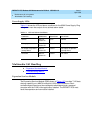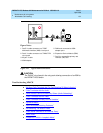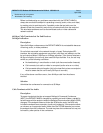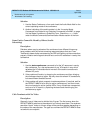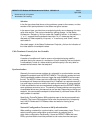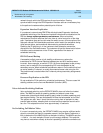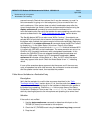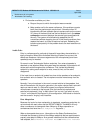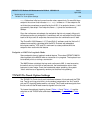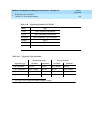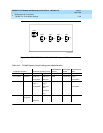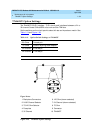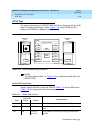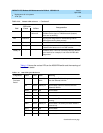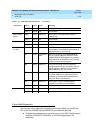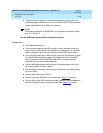
DEFINITY ECS Release 8.2 Maintenance for R8.2csi
555-233-119 Issue 1
April 2000
Maintenance for csi systems
1-98TN760D Tie Trunk Option Settings
1
Rate
fields show initial and current transfer rates, respectively. For each 64-kbps
endpoint the column that indicates
Rate Adapt
shows an
n
if the endpoint did
not follow the procedures as specified by the H.221. If an endpoint shows
y
, it did
successfully rate adapt. If an endpoint shows
c
, it joined the conference at
56kbps.
Once the conference rate adapts, the endpoints that do not properly follow suit,
will become audio-only endpoints. A conference will not rate adapt from 56 kbps
back to 64 kbps until all endpoints disconnect from the conference and it idles.
The PictureTel 1000 Release 1.1C, PictureTel 6.01 software, and the Vistium 2.0
software successfully rate adapt with the MCU. External rate adaptation
techniques used by VTEL and CLI are known to cause problems with the
endpoint when used with this feature.
Endpoint or I-MUX in Loopback Mode
Some endpoints have a loopback enable feature. This makes DEFINITY MMCH
data loopback at the MMCH when a connection is in progress. The loopback can
be enabled prior to or during a connection.
The MMCH does not detect the loop and continues to VAS. In most scenarios,
the switch occurs, but within a few seconds, the broadcaster’s return video
becomes its own image. Once the broadcaster stops speaking, the system
“false” switches to an apparently random port that was not speaking.
TN760D Tie Trunk Option Settings
The TN760D Tie Trunk circuit pack interfaces between 4 tie trunks and the TDM
bus. Two tip and ring pairs form a 4-wire analog transmission line. An E and M
pair are DC signaling leads used for call setup. The E-lead receives signals from
the tie trunk and the M-lead transmits signals to the tie trunk.
To choose the preferred signaling format (
Table 1-10
and
Table 1-11
), set the
switches on the TN760D and administer the port using
Figure 1-28
and
Table
1-12.



